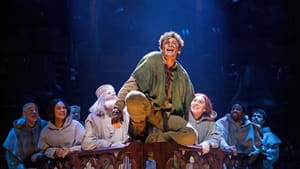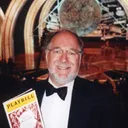Stay in the Loop
BSR publishes on a weekly schedule, with an email newsletter every Wednesday and Thursday morning. There’s no paywall, and subscribing is always free.
Dark Disney
'The Hunchback of Notre Dame' at Paper Mill Playhouse

Another Disney cartoon film is on its way to Broadway. But this adaptation eschews cuteness in favor of medieval darkness, and its score is more choral and symphonic than you’d expect.
This is due to the pairing of two musical titans, Stephen Schwartz (who wrote the words and music for Wicked and Pippin) and Alan Menken (who composed Beauty and the Beast and The Little Mermaid). Each of them wanted to create a more substantial piece than the animated film, so they enlisted a writer with an activist political past, Peter Parnell (The West Wing), to write a new book.
The result is not the kid-friendly fare that we’ve come to expect from the Mickey Mouse factory. The story has a sadder ending, and Menken and Schwartz added songs to the score they wrote for the animated film, creating a major new work. Some kids were there when I attended, but this play is adult and serious.
Schwartz composed an opera, Séance on a Wet Afternoon, so it’s no surprise that he’s inclined toward serious stuff. Menken also had classical training, although his first big hit was the rock-infused Little Shop of Horrors. The two men worked together with the cast as the show was prepared at Paper Mill.
The Hunchback of Notre Dame shares a self-righteous zealot with Les Misérables (which, like Hunchback, is based on a Victor Hugo novel) and melds it with sympathy for an ugly, misunderstood man, like The Phantom of the Opera. That element shares an echo from an earlier work by one of the cocreators. I spoke with Stephen Schwartz at intermission, and he said, “I write a lot of shows with outcasts in the lead. Think of Elphaba in Wicked. That resonates with me.” In fact, Schwartz penned a power ballad, "God Help the Outcasts."
Smart adaptation
Quasimodo (Michael Arden) is a deformed young Parisian who is employed as the bell ringer at the Cathedral of Notre Dame in 1482. He lives in lonely isolation, ashamed of his physical handicap, and is kept under the thumb of his uncle, the archdeacon. His only companions are the bells and the statues of gargoyles, angels, and saints surrounding him.
A particular emphasis is given to Archdeacon Frollo (Patrick Page), a religious and political leader who wants to cleanse Paris of foreigners. He accuses the gypsies of being criminals and a burden on the government and church. How’s that for contemporary relevance?
Still, Archdeacon Frollo is a more dimensional character here than in the movie. He restricts Quasimodo to the bell tower because he thinks he knows how this deformed creature will be treated by a world that does not tolerate difference. Quasimodo sneaks down onto the streets of Paris, where he meets the gypsy Esmerelda (Ciara Renée) and falls in love with her. A complication — the captain of the cathedral guard (Andrew Samonsky) is also in love with Esmerelda, and the sexually obsessed archdeacon inappropriately lusts for her, too.
The set for Hunchback is impressive. We appear to be inside the Notre Dame cathedral, illuminated with reflections from stained glass windows. A choir fills the pews of the church, facing the audience, and their chorales play a major role, intoning Latin hymns and commenting on the action. Six enormous bells are visible above. They descend at key moments to give the impression that the actors are climbing up toward the cathedral’s roof.
Stephen Schwartz’s son Scott directed, smartly adapting old-fashioned theatrical devices. For instance, actor Arden smudges his face and dons his hump, and other players change costumes and adopt new roles, in plain sight. The orchestra is larger than at most musicals these days and displays an almost symphonic lushness.
What, When, Where
The Hunchback of Notre Dame. Music by Alan Menken; lyrics by Stephen Schwartz; book by Peter Parnell; based on the novel by Victor Hugo. Scott Schwartz directed. Through April 5, 2015 at Paper Mill Playhouse, 22 Brookside Drive, Millburn, N.J. 973-376-4343 or www.papermill.org.
Sign up for our newsletter
All of the week's new articles, all in one place. Sign up for the free weekly BSR newsletters, and don't miss a conversation.
 Steve Cohen
Steve Cohen